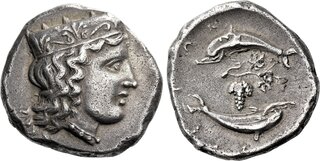| Numismatica Ars Classica > Auction 146 | Auction date: 8 May 2024 |
| Lot number: 2193 Price realized: This lot is for sale in an upcoming auction - Bid on this lot  | Show similar lots on CoinArchives Find similar lots in upcoming auctions on |
| Lot description: Argolis, Argos. Stater circa 370-350, AR 24 mm, 12.01 g. Head of Hera r., wearing stephane decorated with palmette. Rev. [Α ? Ρ ? Γ?Ι? ΩΝ] Two dolphins swimming in circle; between them, bunch of grapes and vine-tendril. BMC 38. Gulbenkian 530 (this reverse die). Jameson 2512 (this reverse die). BCD Peloponnesos 1065 (this reverse die). An exceedingly rare variety of a very rare type. A pleasant old cabinet tone, surface slightly porous and traces of double striking on reverse, otherwise about extremely fine Ex Manhattan II, 2011, Guber, 52; CNG 90, 2012, 555 and CNG 93, 2013, 324 sales. Among the many fabled cities of Greece, Argos claimed to be one of the oldest. Indeed, Homer calls the Greeks 'Argives' in the Iliad, and we may consider this the root for the name Argonaut. During the Bronze Age the territory of Argos incorporated other famous and powerful cities, such as Mycenae and Tiryns, and Argos was still renowned in the 490s B.C. when it began to strike coins. Its first issues were silver drachms and fractions that showed a wolf, symbolic of Apollo Lykios, who was worshipped in the city. The largest Argive coin of this early period, the drachm, shows a wolf in full, whereas triobols show its forepart, and obols show only its head – thus we have a compression of design that coordinates with the decrease in denomination. Hemiobols bore the archaic letter heta, and tetartemoria the letter tau. With a few design modernisations and an occasional new type, this system remained intact for perhaps 120 years. In about 370 – soon after the Battle of Leuctra, which reduced Spartan and Theban influence in the Peloponnesus – Argos began to strike larger denomination coins with fresh designs of high artistry. The period c.370-350 represents the artistic peak for the mint at Argos, with several numismatic masterpieces being created. Argos was famous for its sculptors (including Myron, Polycleitus and Phidias' master, Ageladas), and we may presume the mint was able to draw upon a thriving arts community. The two main issues from this period are staters and drachms. Both show on their obverse the head of Zeus' wife Hera, who wears a stephane decorated with palmettes. About six miles outside the city was the Heraeum, where this goddess is said to have been worshipped for thirteen generations before King Agamemnon ruled over Bronze Age Mycenae. Her original temple burned in 423, so the Hera bust on these coins must be based upon the renowned 26-foot statue by Polycleitus which was adorned with gold and ivory. The Hera staters show on their reverse two dolphins swimming in opposite directions, creating a circular pattern. The Hera drachms show Diomedes, the Argive king of Homer's Iliad, advancing cautiously with sword drawn as he brings to his city the Palladium. The dolphins may be a punning allusion to the Delphic Apollo, who was worshipped at Argos, but perhaps even more likely they reflect the worship of Poseidon based upon two mythological episodes that were etched into the Argive consciousness. In one instance the local river-god Inachus was among those forced by Hera and Poseidon to choose between them for possession of the land; when he chose Hera, Poseidon withdrew the waters. Consequently, as it was explained, the rivers carried water only after a heavy rain. In another episode, Poseidon is said to have created the Springs of Lerna a few miles south of Argos. Apparently, Hera had convinced Poseidon to send back the sea, and the grateful Argives erected a sanctuary to Poseidon Prosclystius ('the flooder') at the point where the tide ebbed. Estimate: 25000 CHF |  |



